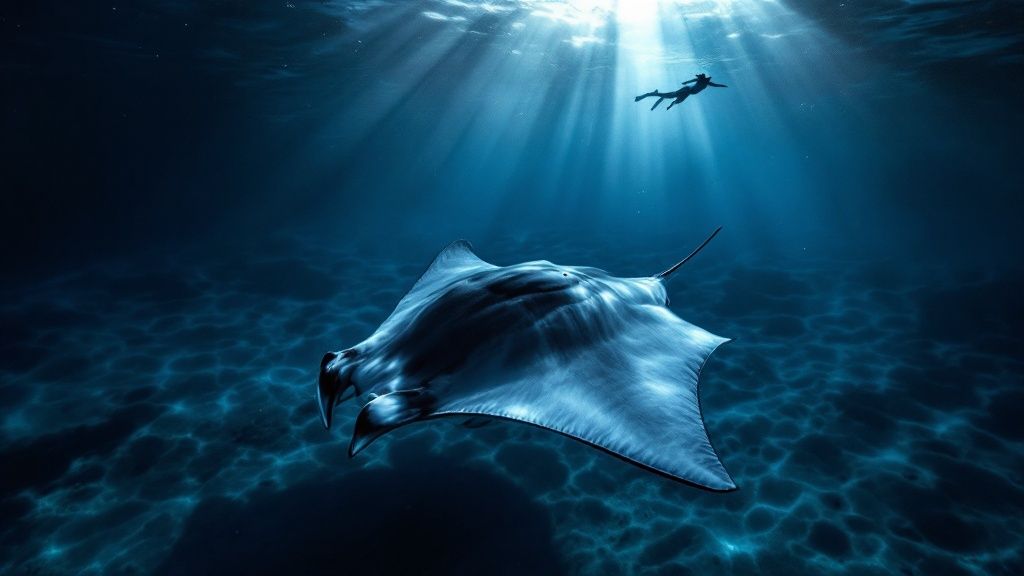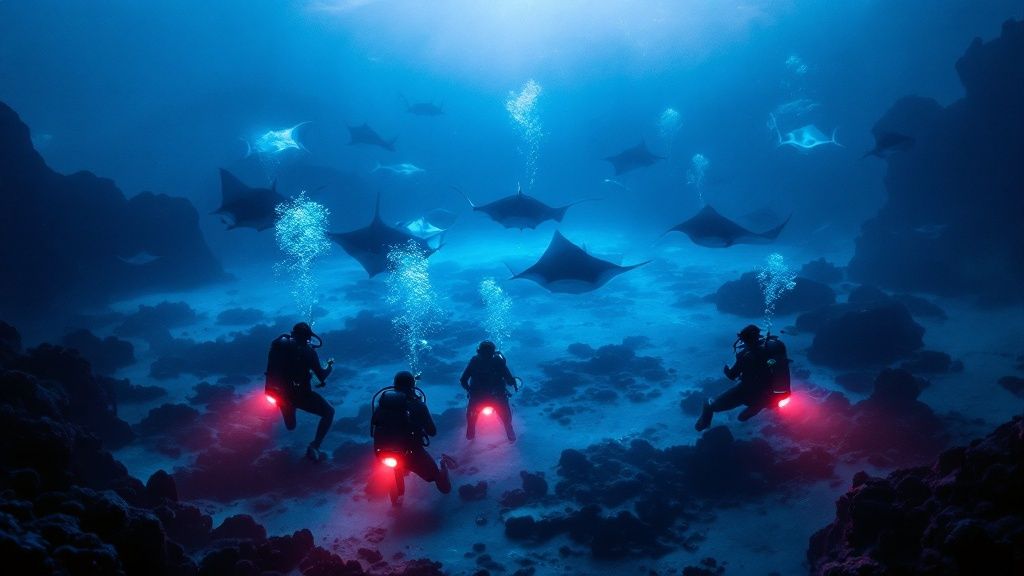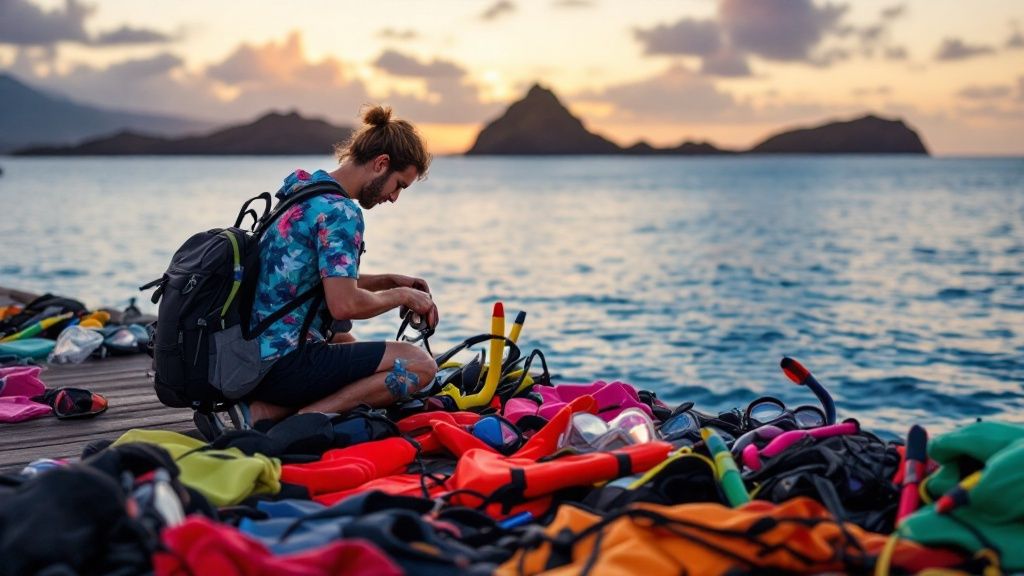Manta Ray Snorkel Kona | Hawaii's Best Underwater Experience
- Byron
- May 15
- 11 min read
The Magic of Manta Ray Encounters in Kona Waters

Floating in the dark Kona waters, watching manta rays glide beneath you, is a truly captivating experience. It's consistently ranked as one of Hawaii's top underwater adventures. But what makes the Kona Coast such a haven for these majestic creatures?
The Kona Coast's unique ecosystem plays a vital role. Volcanic slopes and ocean currents create nutrient-rich upwellings, supporting a thriving plankton population. This abundance of plankton, the manta ray's main food source, attracts these gentle giants.
The Kona Coast boasts a remarkably high frequency of manta ray sightings. Encounters occur roughly 80 to 90% of the time, year-round. This consistency is largely due to tour operators using specialized lighting, which attracts plankton and enhances the manta rays' natural feeding behavior. These encounters also have significant cultural importance and contribute greatly to Hawaii's marine tourism, with an estimated 80,000 participants annually. Popular viewing spots like "Manta Village" and "Manta Heaven" offer ideal feeding environments thanks to the unique combination of underwater lights and plentiful plankton. For more on manta ray statistics, check out this resource: Manta Ray Snorkel Kona Statistics.
Why Kona's Manta Rays Are So Special
Beyond the frequent sightings, Kona offers a profound connection with these gentle giants. Veteran guides and marine biologists often share stories of how these creatures, with wingspans up to 16 feet, interact with snorkelers, fostering a sense of wonder and respect. Even experienced ocean enthusiasts find the Kona manta ray experience uniquely captivating.
These close encounters also promote ocean conservation awareness. Seeing these magnificent animals firsthand inspires a desire to protect their delicate habitat. Want to know more about the captivating manta ray snorkel experience? This guide offers great insights: Manta Ray Snorkel Kona Hawaii: The Ultimate Experience Guide.
Preparing for Your Manta Ray Adventure
This incredible experience is accessible to many. However, good preparation enhances enjoyment. Consider factors like choosing the right tour operator, the best time to visit, and having the appropriate gear. Selecting a sustainable tour operator, for instance, helps ensure the long-term well-being of the manta rays and their environment. Our Sitemap offers more helpful articles on preparation.
Different types of manta ray encounters exist, from quick glimpses to extended observations of feeding behaviors. Each interaction offers a unique perspective on these amazing animals, making every Kona manta ray snorkel a potentially magical and unforgettable experience.
Where the Giants Dance: Prime Manta Ray Viewing Locations

Kona, Hawaii, isn't just a good spot for manta ray snorkel tours—it's one of the best in the world. Beyond the general Kona coast, certain locations hold a special allure for those in the know. Two such spots that stand out are Manta Village in Keauhou Bay and Manta Heaven at Garden Eel Cove. Each has its own distinct characteristics, creating unique and memorable manta ray encounters.
Manta Village: A Protected Haven
Manta Village, nestled in Keauhou Bay, is known for its calm, protected waters. This makes it perfect for families with children and those new to snorkeling. The bay's shallow depth and sandy bottom provide excellent visibility, often allowing snorkelers to glimpse these gentle giants from the surface. The bay's unique shape also helps concentrate plankton, the manta rays' primary food source. This creates a reliable feeding ground, increasing your chances of witnessing their graceful feeding dances.
Manta Heaven: An Immersive Experience
Manta Heaven, at Garden Eel Cove, offers a different kind of encounter. Generally deeper than Manta Village, it provides a more immersive experience. The sandy bottom, dotted with garden eels, creates a rich ecosystem attracting plenty of plankton. While the water here can be less predictable than Keauhou Bay, the payoff can be spectacular: imagine breathtaking views of multiple mantas feeding in unison.
To help you choose the right location, we've compiled a comparison table highlighting the key features of each site.
Introducing "Kona's Top Manta Ray Snorkel Locations Compared," a comprehensive comparison of the main manta ray snorkeling sites in Kona, highlighting the unique features of each location:
Location | Alternative Name | Best Time | Average Depth | Special Features | Accessibility |
|---|---|---|---|---|---|
Manta Village | Keauhou Bay | Sunset - Night | 10-20 feet | Calm, protected waters; ideal for beginners | Easy boat access |
Manta Heaven | Garden Eel Cove | Sunset - Night | 20-30 feet | Deeper water, immersive experience; potential for multiple manta sightings | Boat access |
Other Sites | Varies | Varies | Varies | Less crowded, intimate experiences | Boat or shore access |
This table clearly shows the differences between Manta Village and Manta Heaven, particularly regarding depth and the potential for larger groups of mantas. Other, less frequented sites offer a trade-off: fewer crowds for potentially less predictable manta ray sightings.
Choosing the Right Spot
Choosing between these locations, or exploring lesser-known spots, depends on your experience level and what you're looking for. For a quieter encounter away from larger groups, consider some of the smaller, less publicized sites. For photography enthusiasts, both Manta Village and Manta Heaven offer fantastic opportunities, although lighting and water conditions can change. Check out our blog post archive for more information on manta ray behavior and photography tips. Access also varies; some spots are easily reachable by boat, while others require a shore entry.
Experiencing manta rays is a powerful way to connect with nature. You can even further recharge your life by spending time on the water. Researching the different locations will help you make the best choice for your Kona manta ray snorkel adventure.
The Science and Art Behind Successful Manta Ray Tours

What transforms a simple Kona manta ray snorkel trip into an unforgettable wildlife encounter? It's a blend of science, technology, and human expertise that has made Kona a world-renowned destination for these magnificent creatures. Let's explore the methods behind these successful tours.
The Allure of Light: Attracting Gentle Giants
Manta rays, with their impressive wingspans and gentle nature, are filter feeders. They primarily consume microscopic plankton. This is where the science comes in. Experienced tour operators employ specialized lighting techniques.
These lights aren't ordinary. They are strategically positioned to create a concentrated area of illuminated plankton—a veritable manta ray buffet. This allows snorkelers to witness the captivating feeding behaviors of these gentle giants.
The success of manta ray snorkeling in Kona is due to this unique combination of specialized lighting and the manta rays' natural feeding habits. The consistent presence of mantas allows tour operators to maintain high sighting rates—around 85 to 90%. This translates to roughly 80,000 tour participants annually. Find more detailed statistics here.
The Human Element: Expertise in Action
Technology plays a vital role, but the human element is equally crucial. Highly trained guides are essential for a safe and enriching experience.
These guides possess in-depth knowledge of manta ray behavior, ocean conditions, and respectful wildlife interaction. This ensures the safety of both the snorkelers and the manta rays. Guides carefully orchestrate interactions, maximizing viewing opportunities while minimizing disturbance to the animals' natural feeding patterns.
Sustainable Practices: Protecting Future Encounters
The sustainability of these tours is paramount. Responsible operators prioritize practices that minimize environmental impact and protect the manta ray population. This includes using eco-friendly lighting and adhering to strict guidelines for respectful wildlife viewing.
Maintaining a safe distance and avoiding physical contact helps protect the mantas' delicate skin and mucous layer, vital for their health and immune system. These combined efforts ensure that these incredible encounters remain viable for generations to come. You can explore our blog categories for further insights.
Timing Your Manta Magic: Seasonal Insights and Patterns
Planning your manta ray snorkel Kona adventure requires careful consideration of timing. Understanding the seasonal nuances can significantly improve your experience. By tapping into extensive sighting data and expert knowledge, we can uncover the hidden rhythms of manta ray behavior and the viewing conditions throughout the year.
Lunar cycles, plankton blooms, and changing ocean conditions create specific windows of opportunity. Sometimes, these factors align perfectly. Imagine a calm sea, a vibrant plankton bloom, and excellent visibility – a trifecta for an unforgettable manta ray encounter. Choosing the right season is just as crucial as picking the right tour operator.
Seasonal Variations: A Closer Look
Some months offer the ideal combination of calm seas, clear visibility, and peak manta ray activity. Typically, from April through October, Kona experiences calmer waters and better visibility. This period is perfect for manta ray snorkel Kona trips, especially for first-time snorkelers or those who prefer gentler conditions.
However, mantas can be seen in Kona's waters even during the winter months (November to March). While sightings are still possible, stronger winds and rougher seas can sometimes cause tour cancellations. Visibility can also be affected. This requires more itinerary flexibility and a willingness to reschedule if needed. For more information, check out our sitemap of pages.

The infographic above shows that water temperatures remain relatively stable year-round, while manta ray encounters tend to peak during the warmer months. Tour durations also vary slightly depending on these seasonal factors.
Between 2009 and 2014, a comprehensive study tracked individual manta rays along the Kona Coast, documenting their physiological condition and compiling monthly statistics. This research illuminated manta ray travel patterns within their home range, allowing for better prediction of peak sighting times. This information has been invaluable for both tour operators and conservation efforts. You can find more detailed statistics at Manta Ray Statistics.
To help you plan your trip, we've compiled a table summarizing typical Kona manta ray snorkeling conditions by season:
To help you better understand the conditions throughout the year, we've compiled the following table outlining the typical monthly manta ray snorkeling experience in Kona:
"Manta Ray Snorkeling Conditions by Season in Kona" "Monthly breakdown of manta ray sighting rates, water conditions, and overall experience quality throughout the year"
Month | Sighting Probability | Water Temperature | Visibility | Crowd Levels | Overall Rating |
|---|---|---|---|---|---|
January | Moderate | 75°F - 78°F | Moderate | Low | Good |
February | Moderate | 74°F - 77°F | Moderate | Low | Good |
March | Moderate | 74°F - 77°F | Moderate | Low | Good |
April | High | 75°F - 79°F | Good | Medium | Excellent |
May | High | 76°F - 80°F | Good | Medium | Excellent |
June | High | 77°F - 81°F | Excellent | High | Excellent |
July | High | 78°F - 82°F | Excellent | High | Excellent |
August | High | 79°F - 83°F | Excellent | High | Excellent |
September | High | 79°F - 83°F | Excellent | Medium | Excellent |
October | High | 78°F - 82°F | Good | Medium | Excellent |
November | Moderate | 77°F - 80°F | Moderate | Low | Good |
December | Moderate | 76°F - 79°F | Moderate | Low | Good |
As the table shows, the summer months offer the highest sighting probabilities and best visibility, while the winter months offer a quieter experience with potentially rougher seas.
Planning for the Unexpected: Weather and Contingency
Even with meticulous planning, Kona weather can be unpredictable. Building flexibility into your itinerary is important. Book your manta ray snorkel Kona tour early in your trip. This allows for rescheduling if your initial tour gets canceled due to unexpected weather.
By understanding seasonal trends and being prepared for possible weather disruptions, you can maximize your chances of an amazing manta ray encounter. This preparation enhances your viewing experience and supports responsible tourism by respecting the natural rhythms of these majestic creatures.
From Anxious to Amazed: Preparing for Your Manta Experience
Even seasoned snorkelers might experience a touch of pre-trip excitement before their first manta ray night snorkel adventure in Kona. It's perfectly normal to have questions and a few butterflies before entering the ocean at night. This section addresses those common concerns and offers practical advice to turn any nervous energy into pure anticipation.
Gear Up for Manta Magic: Essentials and Myths
The right gear can significantly enhance your manta ray night snorkel experience in Kona, but what’s truly necessary versus clever marketing? A 3mm wetsuit, even in Kona’s typically warm waters, is essential for night snorkeling, providing much-needed warmth as temperatures dip after sunset. Anti-fog solution is also a must-have for maintaining clear mask visibility, especially in humid conditions. While most operators provide fins, consider bringing your own if you have a preferred pair. For less confident swimmers, a pool noodle offers added buoyancy and can help reduce fatigue.
Essential Gear: Wetsuit, mask, snorkel, fins (often provided), pool noodle (optional)
Helpful Extras: Underwater camera (with low-light capabilities), waterproof case for valuables, towel, dry clothes
Preparing Your Body and Mind
Physical and mental preparation are key to maximizing your in-water enjoyment. You don't need to be a competitive swimmer, but practicing basic snorkeling skills in a pool beforehand can boost confidence, especially if it's been a while since your last snorkel.
Also, consider taking steps to prevent seasickness. If you are prone to motion sickness, talk to your doctor about suitable medication or explore options like acupressure wristbands.
Mental preparation is just as important. Visualizing the experience and focusing on the beauty of the manta rays can help ease any pre-trip anxieties. Deep breathing exercises can also calm nerves in the water, allowing you to fully immerse yourself in the encounter.
Maximizing Your Manta Viewing: Tips From the Pros
Proper positioning is key for optimizing your manta ray viewing opportunities. Experienced guides will instruct you to maintain a respectful distance from the mantas, avoiding any physical contact that could damage their delicate mucous layer. They'll also demonstrate the best positions for unobstructed views without interfering with the mantas' natural feeding behavior. Remember, these gentle giants boast a wingspan reaching up to 16 feet, so even from a safe distance, the sight is truly breathtaking.
Stay calm and float: Avoid sudden movements or splashing.
Position yourself horizontally: This minimizes disturbance to the mantas and offers a wider viewing angle.
Follow your guide's instructions: They are experts at positioning snorkelers for optimal viewing.
From Booking to Dry Land: What to Expect
Understanding the process from booking your manta ray night snorkel Kona tour to returning to dry land can significantly smooth the overall experience. Most tours include a pre-trip briefing covering manta ray biology, behavior, and safe interaction guidelines. You'll receive all the necessary snorkeling equipment, and guides will be on hand to address any questions. After the snorkel, most operators offer hot drinks and snacks—a perfect way to warm up and reflect on the magical encounter.
By preparing both physically and mentally, and by understanding the essential gear and best viewing practices, you'll transform pre-trip jitters into feelings of awe and wonder, allowing you to fully appreciate the magic of these graceful giants in their natural habitat.
Becoming a Manta Ray Conservation Ally Through Tourism
Your manta ray snorkel Kona adventure offers more than just an exciting excursion; it's a chance to contribute to something meaningful. Responsible tourism is becoming a vital force in safeguarding these vulnerable creatures, thanks to the unwavering efforts of marine conservation experts and researchers.
Decades of Dedication: Tracking Individual Mantas
For decades, innovative identification systems have been used to track individual manta rays. Much like human fingerprints, each manta possesses a unique ventral spot pattern. These patterns enable researchers to identify and monitor individual animals, unveiling captivating life histories and migration routes.
This long-term data collection is essential for understanding population dynamics and the overall health of manta ray communities. It helps us learn more about their behaviors and develop effective protection strategies.
Threats to Manta Rays: Global and Local Concerns
Manta rays face numerous threats, both globally and locally in Hawaii. Fishing pressure, including targeted fishing and accidental bycatch, presents a significant danger. Furthermore, habitat degradation and the effects of climate change, such as rising ocean temperatures and ocean acidification, pose additional risks to these gentle giants.
These combined pressures highlight the urgent need for conservation initiatives, emphasizing the critical role of responsible tourism.
Your Tour Choice Matters: Supporting Conservation Efforts
The tour operator you choose has a direct impact on conservation work. By selecting operators dedicated to sustainable practices, you directly support research and protection programs.
Consider asking operators about their use of eco-friendly lighting, their adherence to responsible wildlife interaction guidelines, and their contributions to research projects. These questions can help ensure your tour positively contributes to manta ray conservation.
Making a Difference: Contributing to Research
You can contribute to manta ray research during your manta ray snorkel Kona trip. Many operators actively participate in data collection, and your observations can be invaluable. Reporting sightings of tagged mantas or documenting new behaviors, for example, helps broaden our understanding of these creatures.
Some tours even offer opportunities to participate in citizen science projects, providing a chance to actively engage in conservation. You can also find related articles on our blog categories sitemap.
Citizen Scientists: Making Real Impacts
Participants like you have contributed significantly to manta ray conservation. They've helped document new behaviors, identify previously unknown individuals, and even influence policy changes that protect these magnificent animals.
By choosing a responsible tour and actively participating in data collection, you become a vital part of the manta ray conservation story. This collaborative effort ensures future generations can also experience the wonder of these gentle giants.
Ready to embark on your unforgettable manta ray adventure? Book your tour with Manta Ray Night Snorkel Kona Hawaii Tours today and experience the magic while contributing to their protection: Book Your Manta Ray Snorkel Kona Adventure Now!
Comments